Covalent bonds Study guides, Revision notes & Summaries
Looking for the best study guides, study notes and summaries about Covalent bonds? On this page you'll find 5207 study documents about Covalent bonds.
All 5.207 results
Sort by
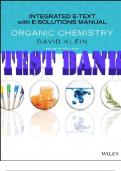
-
TEST BANK for Organic Chemistry: 4th Edition by David R Klein. INTEGRATED WITH SOLUTIONS MANUAL. All Chapters 1-27 in 2150 Pages.
- Exam (elaborations) • 2150 pages • 2023
-
- $29.98
- 24x sold
- + learn more
Document Content and Description Below TEST BANK for Organic Chemistry: 4th Edition by David R Klein. INTEGRATED WITH SOLUTIONS MANUAL. All Chapters 1-27 in 2150 Pages. TABLE OF CONTENTS 1 A Review of General Chemistry 1.1 Introduction to Organic Chemistry 1.2 The Structural Theory of Matter 1.3 Electrons, Bonds, and Lewis Structures 1.4 Identifying Formal Charges 1.5 Induction and Polar Covalent Bonds 1.6 Reading Bond-Line Structures 1.7 Atomic Orbitals 1.8 Valence Bond Theory 1.9 Molecular Or...
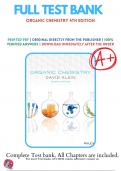
-
Test Bank for Organic Chemistry, 4th Edition by David R. Klein | 9781119659594|Chapter 1-27 | All Chapters with Answers and Rationals
- Exam (elaborations) • 2151 pages • 2023 Popular
- Available in package deal
-
- $24.14
- 15x sold
- + learn more
Test Bank for Organic Chemistry 4e 4th Edition by David R. Klein. ISBN-13: 9594 Full chapters test bank PDF TABLE OF CONTENTS 1 A Review of General Chemistry: Electrons, Bonds, and Molecular Properties 1 1.1 Introduction to Organic Chemistry 2 1.2 The Structural Theory of Matter 3 1.3 Electrons, Bonds, and Lewis Structures 4 1.4 Identifying Formal Charges 7 1.5 Induction and Polar Covalent Bonds 8 1.6 Reading Bond-Line Structures 11 1.7 Atomic Orbitals 14 1.8 Valence Bond Theory 17 1.9 Molecular...
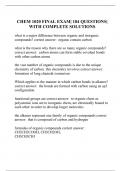
-
CHEM 1020 FINAL EXAM| 184 QUESTIONS| WITH COMPLETE SOLUTIONS
- Exam (elaborations) • 20 pages • 2023
- Available in package deal
-
- $15.49
- 3x sold
- + learn more
what is a major difference between organic and inorganic compounds? correct answer: organic contain carbon what is the reason why there are so many organic compounds? correct answer: carbon atoms can form stable covalent bonds with other carbon atoms the vast number of organic compounds is due to the unique chemistry of carbon. this chemistry involves correct answer: formation of long chains& isomerism Which applies to the manner in which carbon bonds in alkanes? correct answer: the...
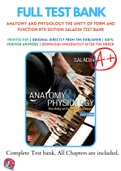
-
ANATOMY AND PHYSIOLOGY THE UNITY OF FORM AND FUNCTION 8TH EDITION SALADIN TEST BANK
- Exam (elaborations) • 1068 pages • 2022
- Available in package deal
-
- $26.48
- 7x sold
- + learn more
Chapter 02 The Chemistry of Life Answer Key True / False Questions 1. Minerals are organic elements extracted from the soil by plants. FALSE Accessibility: Keyboard Navigation Blooms Level: 1. Remember Gradable: automatic HAPS Objective: O01.01e List the important dietary minerals and describe the major uses of each mineral in the body. HAPS Topic: Module O01 Nutrition. Learning Outcome: 02.01c State the functions of minerals in the body. Section: 02.01 Topic: Atoms and molecules 2. Molecules co...
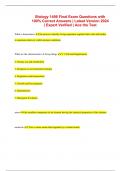
-
Biology 1406 Final Exam Questions with 100% Correct Answers | Latest Version 2024 | Expert Verified | Ace the Test
- Exam (elaborations) • 115 pages • 2024
- Available in package deal
-
- $15.49
- 1x sold
- + learn more
What is homeostasis the process whereby living organisms regulate their cells and bodies to maintain relatively stable internal conditions What are the characteristics of living things 1. Cells and Organization 2. Energy use and metabolism 3. Response to environmental changes 4. Regulation and homeostasis 5. Growth and Development 6. Reproduction 7. Biological Evolution atom the smallest component of an element having the chemical properties of the element molecule Two or more atoms he...
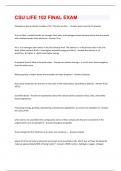
-
CSU LIFE 102 FINAL EXAM QUESTIONS & ANSWERS SOLVED 100% CORRECT!
- Exam (elaborations) • 17 pages • 2024
- Available in package deal
-
- $7.99
- 1x sold
- + learn more
Phosphorus has an atomic number of 15. This tells us that... - Answer-there must be 15 protons True or False: covalent bonds are stronger than ionic and hydrogen bonds because atoms that are joined with covalent bonds share electrons - Answer-True An e- in a hydrogen atom exists in the first valence shell. The valence e- of Aluminum exist in the 3rd shell. Which valence shell e- have higher potential energy and why? - Answer-the valence e- of aluminum, bc higher e- shells have higher energy...
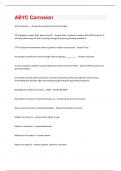
-
ABYC Corrosion Exam (Questions and Answers)
- Exam (elaborations) • 15 pages • 2024
- Available in package deal
-
- $7.99
- 1x sold
- + learn more
GFCI stands for... - Answer-Ground Fault Circuit Interrupter T/F A galvanic isolator WILL block stray AC. - Answer-False. A galvanic isolator WILL NOT block AC. It will only blocks stray DC that is moving through the green grounding conductor. T/F An isolation transformer makes a galvanic isolator unnecessary. - Answer-True. An isolation transformer works through electromagnetic _________. - Answer-Induction A reverse polarity indicator is placed between which two wires? Why? - Answer-White...
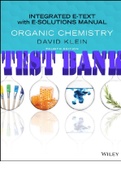
-
TEST BANK for Organic Chemistry: Integrated with Solutions Manual 4th Edition by David Klein . ISBN 9781119776741. (All Chapters 1-27 in 2150 Pages)
- Exam (elaborations) • 2150 pages • 2023
-
- $33.31
- 2x sold
- + learn more
Organic Chemistry: Integrated with Solutions Manual 4th Edition. ISBN 6741, 0. All Chapters 1-27 in 2150 Pages. (Complete Download) TEST BANK & SOLUTIONS MANUAL TABLE OF CONTENTS 1 A Review of General Chemistry 1.1 Introduction to Organic Chemistry 1.2 The Structural Theory of Matter 1.3 Electrons, Bonds, and Lewis Structures 1.4 Identifying Formal Charges 1.5 Induction and Polar Covalent Bonds 1.6 Reading Bond-Line Structures 1.7 Atomic Orbitals 1.8 Valence Bond Theory 1.9 Molecular Orbital The...
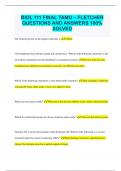
-
BIOL 111 FINAL TAMU – FLETCHER QUESTIONS AND ANSWERS 100% SOLVED
- Exam (elaborations) • 19 pages • 2023
- Available in package deal
-
- $9.99
- 1x sold
- + learn more
BIOL 111 FINAL TAMU – FLETCHER QUESTIONS AND ANSWERS 100% SOLVED The element present in all organic molecules is Carbon Cell membranes have distinct inside and outside faces. Which of the following statements is the most likely explanation for the membrane's asymmetrical nature? The two sides of a cell membrane face different environments and carry out different functions Which of the following statements is true about buffer solutions? They maintain a relatively constant pH when either aci...
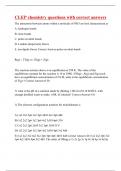
-
CLEP chemistry questions with correct answers
- Exam (elaborations) • 13 pages • 2023
- Available in package deal
-
- $14.49
- 1x sold
- + learn more
The attractions between atoms within a molecule of NH3 are best characterized as A. hydrogen bonds B. ionic bonds C. polar covalent bonds D. London (dispersion) forces E. ion-dipole forces Correct Answer-polar covalent bonds R(g) + 2T(g) ⇌ 2X(g) + Z(g) The reaction mixture above is at equilibrium at 298 K. The value of the equilibrium constant for the reaction is 16 at 298K. If R(g) , X(g) and Z(g) each have an equilibrium concentration of 2.0 M, what is the equilibrium concentrati...

Do you wonder why so many students wear nice clothes, have money to spare and enjoy tons of free time? Well, they sell on Stuvia! Imagine your study notes being downloaded a dozen times for £15 each. Every. Single. Day. Discover all about earning on Stuvia


